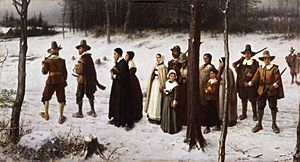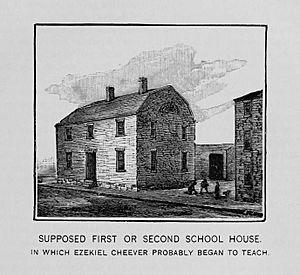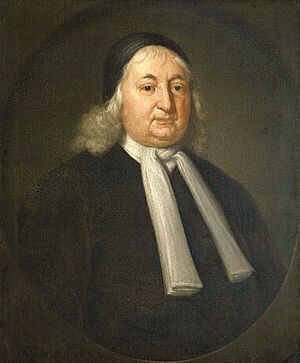History of the Puritans in North America facts for kids
In the early 1600s, many English Puritans moved to North America, mostly to New England. Puritans were very religious members of the Church of England. They believed the church needed to be "purified" and changed. They felt it still had too many old Roman Catholic ideas.
Most Puritans were "non-separating." This means they wanted to fix the Church of England from the inside. They did not want to create new, separate churches. A smaller group, called "separating Puritans," did want to form their own churches. The Pilgrims were one of these Separatist groups. They started the Plymouth Colony in 1620.
Puritans played a big role in starting other colonies. These included the Massachusetts Bay Colony (1629), the Saybrook Colony (1635), the Connecticut Colony (1636), and the New Haven Colony (1638). Some settlers who were kicked out of Massachusetts for their religious ideas started the Colony of Rhode Island and Providence Plantations. Puritan influence in America began to fade in the early 1700s.
Contents
Who Were the Puritans?
Puritanism was a Protestant movement that started in England in the 1500s. Its main goal was to make England a more religious society. They wanted to change the Church of England by removing all remaining Roman Catholic traditions.
During the rule of Elizabeth I, Puritans were mostly allowed to practice their beliefs. Many English Protestants at the time shared similar ideas. However, Puritans disagreed with church leaders on certain ceremonies. They thought things like wearing special robes, kneeling for Holy Communion, and making the sign of the cross during baptism were too Catholic.
Under King James I, many Puritans no longer wanted to wait for church reforms. Some separated from the Church of England. Since everyone had to attend church services by law, these Separatists faced legal trouble. Some were even executed. To escape this, some Separatists moved to the Netherlands. Still, most Puritans stayed within the Church of England.
When King Charles I became ruler, things got worse for Puritans. Bishops became less tolerant of their views. They forced people to use the controversial ceremonies. Puritan preachers were controlled, and some ministers lost their jobs. Many Puritans then felt they had no choice but to leave England.
Moving to America: The Great Migration
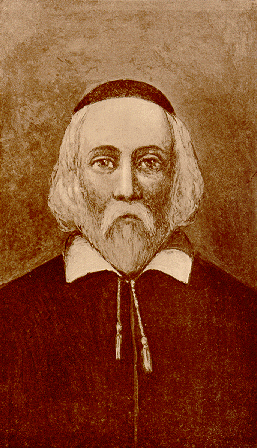
In 1620, a group of Separatists called the Pilgrims settled in New England. They started the Plymouth Colony. The Pilgrims were a church group from Scrooby, England. They faced persecution, with some members being jailed or losing their property. To avoid more trouble, they moved to Leiden, a city in the Netherlands.
In 1620, the Pilgrims got permission to settle in New England. They sailed on the ship Mayflower and landed at Plymouth Rock. The Pilgrims are famous for creating the Mayflower Compact. This was an agreement for self-government. It was based on their Puritan beliefs and their church's own agreements.

Some Pilgrims believed that Cape Ann would be a good place for a settlement. They formed a group called the Dorchester Company. In 1622, they got permission to settle there. Based on this, Roger Conant led a group of fishermen to found Salem in 1626.
Other Puritans became convinced that New England could be a safe place for their religion. Their effort was reorganized as the Massachusetts Bay Company. In March 1629, they received a special paper from King Charles. This paper allowed them to start the Massachusetts Bay Colony. In 1630, the first ships of the Great Puritan Migration sailed to the New World. They were led by John Winthrop.
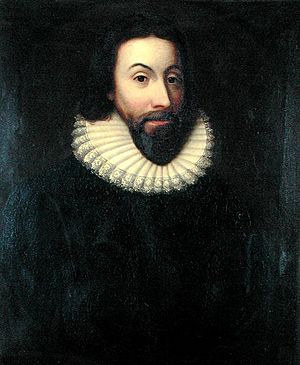
During the trip, Winthrop gave a famous speech called "A Model of Christian Charity". He told his followers they had a special agreement with God. If they stayed true to God, He would help them succeed. Their new colony would be like a "City upon a Hill." This meant it would be an example to all of Europe of a perfect Christian community.
Most Puritans who moved settled in New England. The Great Migration was short but very large. It began in 1629 with the Massachusetts Bay Colony. It ended in 1642 when the English Civil War started. King Charles I then stopped people from leaving for the colonies. From 1629 to 1643, about 21,000 Puritans moved to New England.
This migration was mostly families. Between 1630 and 1640, over 13,000 men, women, and children sailed to Massachusetts. Unlike other colonies, Puritan ships carried "ordinary" people of all ages. Only about a quarter of the people were in their twenties. This meant New England settlements had a more normal mix of ages. In the Colony of Virginia, there were many more men than women. But nearly half of the Puritan immigrants were women. This helped New England's population grow quickly. Puritan women were very important to the success of the colonies.
Other Destinations
The struggle between the Church of England and Puritan groups spread across the English lands. This led to people moving from places like Bermuda. About 10,000 Bermudians moved before 1775. Many went to the American colonies, especially in the South. Some went to the Bahamas. There, Bermudian Puritan families started the colony of Eleuthera in 1648.
More people moved during the rule of Oliver Cromwell in the 1650s. But the numbers were not as large. This was because Puritans no longer needed to escape persecution in England. Some Puritans even returned to England during the English Civil War. They were on the winning side and stayed under Cromwell's Puritan rule.
Life in the New World
Puritan power in the New World lasted until the early 1700s. This time can be divided into three periods. The first was from 1630 to 1662, a time of independence. The second was from 1662 to 1689, a time of struggle with the British crown. The third was from 1689 to 1728, when new changes happened.
Religion and Church Life
Once in New England, Puritans set up Congregational churches. These churches followed Reformed theology. They adopted the Savoy Declaration as their statement of beliefs.
The Cambridge Platform explains how Puritans ran their churches in the 1600s. Each church was based on a "church covenant." This was a written agreement signed by all members. They promised to follow church rules and use the Bible for decisions. Each church could elect its own leaders and manage its own matters.
Puritans had two main church roles: elder and deacon. Ministers were called "teaching elders." They preached and gave sacraments. Important church members were chosen as "ruling elders" for life. They helped lead the church. Deacons mostly handled money. Over time, most churches had only ministers and deacons.
Puritans believed people were saved by God's grace alone. They did not believe good actions earned salvation. However, they also thought people should try to be "appropriate vessels" for God's grace. They could do this by reading the Bible, praying, and doing good deeds. This idea was called "preparationism."
The process of becoming a Christian had three main steps. First was sorrow for sinning against God. Second was feeling forgiven and accepted by God. Third was living a holy life out of joy for God.
Puritans believed churches should only have "visible saints" as members. These were people who showed signs of being chosen by God. To join, people had to tell their personal story of becoming a Christian. All settlers had to attend church services. But only full members could take part in the Lord's Supper. They also practiced infant baptism. Only church members could present their children for baptism.
Church services were held on Sunday mornings and afternoons. There was also a service during the week. Men and women sat on opposite sides of the church. Children sat in their own section. A "tithingman" watched over them and corrected misbehaving children. The pastor would pray, and then the teacher would read and explain a Bible passage. A ruling elder would lead a Psalm song. Then the pastor would preach for an hour or more.
Church and Government
Puritans believed that society was held together by a "social covenant." Examples include Plymouth's Mayflower Compact and Massachusetts' colonial charter. People were responsible for choosing good leaders. These leaders got their power from God and had to work for the common good. If a ruler was bad, people had the right to oppose him. These ideas helped New Englanders support revolutions in England and later the American Revolution.
Puritans also believed they had a special agreement with God as a nation. They thought God had chosen them to help improve the world by obeying Him completely. If they followed God, they would be blessed. If not, they would fail. Because of this, the government had to make sure people followed moral rules. It also had to ensure true religious worship was established.
In the Puritan colonies, the Congregational church was the official religion. In Massachusetts, no new church could start without permission from existing churches and the government. Connecticut also allowed only one church per town, which had to be Congregational.
Everyone in Massachusetts and Connecticut had to pay taxes to support the Congregational churches. This was true even for people who had different religious beliefs. Only Congregational church members could vote in Massachusetts and New Haven. But voting rights were wider in Connecticut and Plymouth. In Connecticut, attending church on Sundays was required. Those who missed were fined.
There was more separation between church and government in Puritan colonies than in Europe. In England, the king led both church and state. Bishops were part of the government. In New England, civil matters were handled only by government leaders. Church officials could not hold government jobs. When dealing with people who had different beliefs, the church would try to persuade them. If that failed, they might remove them from the church. But even excommunicated citizens could still vote in civil matters.
Religious Freedom
Puritans did not come to America to create a theocracy (a government ruled by religious leaders). But they also did not create religious freedom. Puritans believed the government had to protect society from wrong religious ideas. They could use physical punishment, banishment, or even execution. New England leaders did not look into private beliefs. But they did act against public disagreement with the official religion.
For example, Nathaniel Ward wrote that people with different beliefs should "keep away from us." He said if they came, they should "be gone as fast as they can."
Between 1658 and 1692, some Quakers were executed. Baptists were also jailed. Quakers were often sent away by the courts. But they would often return, challenging the authorities. Historian Daniel Boorstin said that Puritans did not seek to punish Quakers. Instead, Quakers came looking for punishment.
Family Life
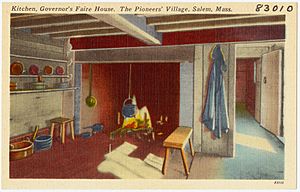
For Puritans, the family was very important for spiritual and community growth. Marriage was the base of the family and society. In England, ministers married people in churches. But Puritans saw no Bible reason for church weddings or wedding rings. They saw marriage as a religious agreement between a man and woman. But the wedding itself was a private, legal event. A civil leader would perform the ceremony at home. Massachusetts ministers were not allowed to perform marriages until 1686.
Some historians say Puritan child-rearing was very strict. They point to John Robinson, the Pilgrims' first pastor. He wrote that children had a "stubbornness" that needed to be "broken down." However, other scholars say Robinson's views were not typical. They argue that Puritan parents used an "authoritative" style, not an "authoritarian" one. They wanted to teach good behavior and reason. Physical punishment was used only as a last choice.
Education
Puritans were very educated. About 60 percent of people in New England could read. This was much higher than in England, where less than 30 percent could read. Puritan leaders believed children should be educated for both religious and civil reasons. They worked to make sure everyone could read.
In 1642, Massachusetts required household heads to teach their wives, children, and servants to read and write. This was so they could read the Bible and understand laws. In 1647, the government required towns with 50 or more households to hire a teacher. Towns with 100 or more households had to hire a grammar school teacher. This was to prepare smart boys for college. Boys who wanted to become ministers often went to colleges like Harvard (founded in 1636) or Yale (founded in 1707).
Puritans believed a child's mind was like an "empty container." It needed to be filled with knowledge through careful teaching. They wanted their children to read and understand the Bible themselves. This led to people thinking for themselves, which is a key part of democracy.
The Puritans set up schools for their sons soon after arriving in America. They also set up "dame schools" for their daughters. Or they taught their daughters at home how to read. As a result, Americans became some of the most educated people in the world. By the time of the American Revolution, the United States had 40 newspapers. It also had 10 colleges, while England had only two.
Fun and Free Time
Puritans did not celebrate traditional holidays like Christmas, Easter, or May Day. They also did not celebrate personal holidays like birthdays. However, they did celebrate special events. These included military victories, good harvests, weddings, and births. These celebrations involved food and talking. Taverns were also important places for people to gather regularly.
Dancing was not encouraged at weddings or on holidays. It was illegal in taverns.
Puritans had no religious problems with sports and games. But they were against gambling. This meant activities like billiards, horse racing, and card games were not allowed. They also opposed violent sports like cockfighting. Team sports like football were a problem because they encouraged laziness and caused injuries. Hunting and fishing were approved because they were useful. Other sports like marksmanship, running, and wrestling were encouraged.
Only a few activities were completely forbidden by Puritans. They were most against theater. All forms of gambling were illegal. Gambling was seen as against family values and honesty. It was also religiously offensive. Gamblers were seen as asking God to get involved in small matters. This broke the Third Commandment against using God's name in vain.
Slavery
Slavery was allowed in colonial New England. However, enslaved people made up less than three percent of the workers. Most Puritan ministers accepted slavery because it was mentioned in the Bible. But they also believed that all people, no matter their race, had souls. They could also receive God's grace. Because of this, enslaved and free Black people could become full church members. However, meetinghouses and burial grounds were separated by race.
Puritan influence meant that enslaved people were treated better in New England than in the Southern Colonies. In Massachusetts, the law gave enslaved people "all the liberties and Christian usages" that God's law required. This meant enslaved people had the same protections against bad treatment as white servants. Marriages of enslaved people were legally recognized. Enslaved people also had the right to a trial by jury, even if accused by their owner.
The first people to speak out against slavery were Puritans. For example, in 1700, Massachusetts judge and Puritan Samuel Sewall wrote "The Selling of Joseph." This was the first anti-slavery paper written in America. In it, Sewall condemned slavery and the slave trade. He also argued against common reasons given for slavery at the time.
The Puritan influence on slavery was still strong during the American Revolution and after. In the years leading up to the American Civil War, people who wanted to end slavery, like Theodore Parker and Frederick Douglass, often used the country's Puritan history to support their cause. The most radical anti-slavery newspaper, The Liberator, mentioned Puritans and Puritan values over a thousand times.
Decline of Puritan Influence
The power of the Puritans and Congregational churches slowly decreased. This happened partly because of practices like the Half-Way Covenant. It also happened because other religious groups grew. These included Baptists, Quakers, Anglicans, and Presbyterians in the late 1600s and early 1700s.
There is no exact date when the Puritan era ended. But most agree it was over by 1740. By this time, the Puritan tradition was splitting into different groups. Historian Thomas S. Kidd says that after 1689, the goals of New Englanders had changed so much that they could no longer be called Puritans.
Today, churches that came directly from the New England Puritan churches include the Congregationalist Churches. These are part of the larger Reformed tradition. Examples are the United Church of Christ, the National Association of Congregational Christian Churches, and the Conservative Congregational Christian Conference. The United Church of Christ is a direct continuation of the Congregational churches started by Puritans.
See also


